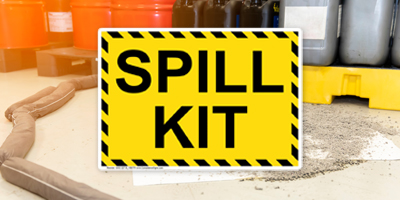Why Spill Clean-Up and Control Signs Are a Smart Choice
Chemicals are present in most workplaces, from agriculture to offices, and can pose potential hazards to workers. Spilling chemicals that are corrosive, toxic, flammable or reactive can create dangerous situations. And accidents do happen.
When spills occur, immediate action may be necessary to prevent injuries and minimize damage. But spill clean-up and control is no simple task. Train workers to recognize hazards and know how to respond correctly to different spills. Access to material safety data sheets (MSDS) is important for each chemical encountered.
Spill control station signs direct workers to spill kits and supplies. SDS Station signs make it easy to find critical information about the chemical that has spilled. These elements and more should be part of a comprehensive spill plan.
Make spill control signs from ComplianceSigns part of your safety and spill plan to keep workers safe.
Make A Spill Plan
Your safety plan should include a spill plan that explains what to do in case of a spill of any chemical used on your worksite. It should include clean-up information from Safety Data Sheets (SDS). Be sure you have correct PPE and spill control materials on hand, and train workers how to use them.
Include detailed instructions about safe containment, cleanup and disposal of spilled materials. If needed, describe steps to safely decontaminate the area, as well.
A spill plan also should include a list of everyone who needs to be contacted, based on the nature and severity of the spill. Consider posting emergency contact signs with phone numbers wherever hazardous chemicals are in use. Include information on whether evacuation is needed, and how to evacuate.
Prevent Spills Before They Happen
The best approach is to prevent spills from happening. Always follow proper procedures for storing, handling, using and disposing of chemicals, as noted in the SDS. A variety of chemical storage safety cabinets are available to help ensure safe chemical storage. Proper PPE is essential, and clear, organized workspaces will also help prevent spills.
Four Cs for Spill Control and Clean Up
Only the SDS can address the exact clean-up needs for any specific chemical, but there are four general steps for spill control:
Communicate the Hazard - Immediately notify others working in the area and supervisors of the spill. Contact emergency responders if needed.
Control the Spill - Take steps to prevent the spill from getting worse, such as setting the container upright, closing valves, etc. This may require PPE. Eliminate possible ignition sources.
Contain the Hazard - Use spill kit materials or other safety supplies that absorb or neutralize the chemical to prevent it from spreading.
Clean Up the Spill - Collect the material used to contain the spill and dispose of it according to spill plan or SDS instructions. Clean all surfaces affected by the spill.
Spill Clean-up and Control Resources:
What Is a Chemical Spill Kit and How Do You Use It?
American Chemical Society Guide for Chemical Spill Response
OSHA Emergency Preparedness and Response Information
Hazardous Waste Operations and Emergency Response (HAZWOPER)
OSHA Occupational Chemical Database
Cleanup Laws, Regulations and Guidance from the EPA



